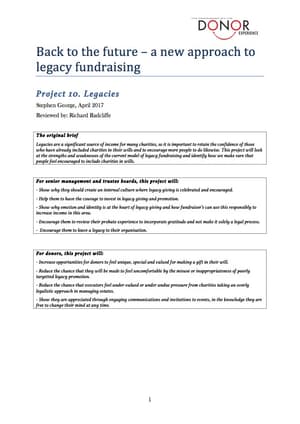CDE project 10 section 4 part 2: the experiences and needs of donors and their families
- Written by
- The Commission on the Donor Experience
- Added
- April 26, 2017
At the heart of the challenge of providing the best experience are the primary wishes of the donors and their families. For donors to feel comfortable discussing legacies, they must know, feel and understand that a charity is not in competition with their families. A charity is a partner and a potentially welcome solution to a donor’s needs. In the past, charity marketing messages have created a sense of conflict with the natural instinct to give to family first; thus, it is essential that charities to market themselves in a way that puts family first, even though some supporters may not have families, as the instinct is still there.
If the fundraising model used to engage supporters focuses solely on revealing intent, it is failing. What is perhaps worse, it is misunderstanding the donors’ wishes, fears, anxieties and understanding of legacies. As a result, no conversation, intention or action may have been disclosed to the charity receiving a legacy gift. People are naturally private, particularly in a climate in while leaving a charitable bequest is not a social norm. Unexpected gifts appearing from an unknown donor are a mainstay of legacy fundraising. For many, it constitutes the majority of their gifts, and it often helps to understand this. One way is to count the sources systematically:
a. Gifts from people you have never heard from and who are not known to you
b. Gifts from people you know or who are on your database in some way, but have never disclosed or discussed an intention to leave a gift
c. Gifts from people you know who have previously disclosed that they are either considering a gift, planning to give a gift, or have already done so.
It is important to recognise that all gifts received are from supporters. Because someone is not known to you does not indicate a lack of support, but shows the donor has chosen not to tell you about their support or has not disclosed by his or her behaviour. What of the donor who watches you from afar with admiration, crossing the street to put cash in a street collection tin for you?
Most gifts are the product of influence rather than direct response. But, when we do have a direct response and donors have revealed their intent, we need to make sure we step up to an even higher level of stewardship. Data from the NCP G 2001 collected by Adrian Sargent reveal that only 25% of donors who had informed the charity of their bequest intentions experienced being treated any differently as a consequence. He concluded that these pledgers are placing greater emphasis on the quality of service they receive and, in this case, we fall short of serving their needs.
The question to ask is, why don’t people reveal their intent? What prevents a conversation? (see TNS Research in the overview section). Could it be that our pursuit of a ‘pledge’ or more simply a ‘please tell us’ has clashed with the natural tendency towards privacy?
For many supporters, a gift in a will is something that takes time to consider, to reflect on and on which to act. A minority may move through these stages more rapidly, usually due to personal circumstances but, for most, the process takes time. Prochaska’s model, as described previously, provides an insight into the stages used to make decisions.
This model is used to inform actions taken in social campaigns to change behaviour, and has been used to illustrate a legacy approach at Remember a Charity, the NSPCC and others. Fundraisers should seek to focus on driving a great experience by recognising the longer decision making process and creating a broader, longer-term consideration to action approach that engages and inspires. The ‘pledge’ will remain as a natural cornerstone, which is donors revealing that they have left a gift, but the volume and influence is greater in the softer majority of donors who are considering but haven’t yet acted or revealed intent.



















